Exploring Remote Intelligence: A Marketing & Management Perspective
VerifiedAdded on 2023/06/11
|10
|2233
|457
Report
AI Summary
This report examines the increasing prevalence of remote intelligence, defined as hiring remote workers, within marketing and management contexts. It highlights the factors driving its adoption, such as reduced employment and real estate costs for businesses, and improved work-life balance for employees. The report also addresses the potential threats to workforce sustainability, including skill gaps and communication challenges. Ethical considerations in managing remote workers are discussed, along with the benefits of cost reduction and enhanced productivity, and the disadvantages of lacking community and cultural differences. The report concludes by outlining the leadership styles necessary to effectively manage remote teams, emphasizing the need for indefatigable leaders and company evangelists. Desklib offers similar solved assignments and resources for students.
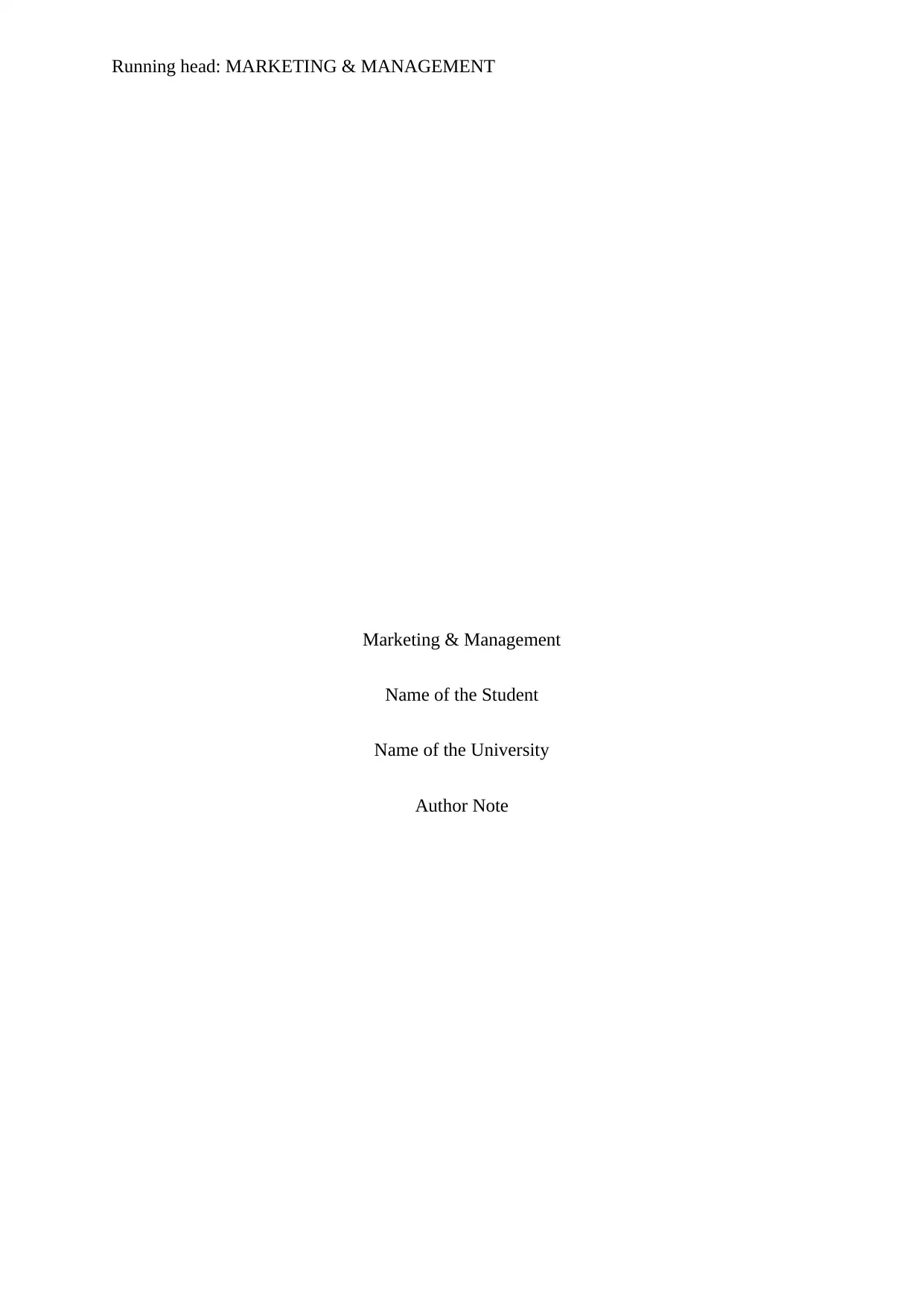
Running head: MARKETING & MANAGEMENT
Marketing & Management
Name of the Student
Name of the University
Author Note
Marketing & Management
Name of the Student
Name of the University
Author Note
Paraphrase This Document
Need a fresh take? Get an instant paraphrase of this document with our AI Paraphraser
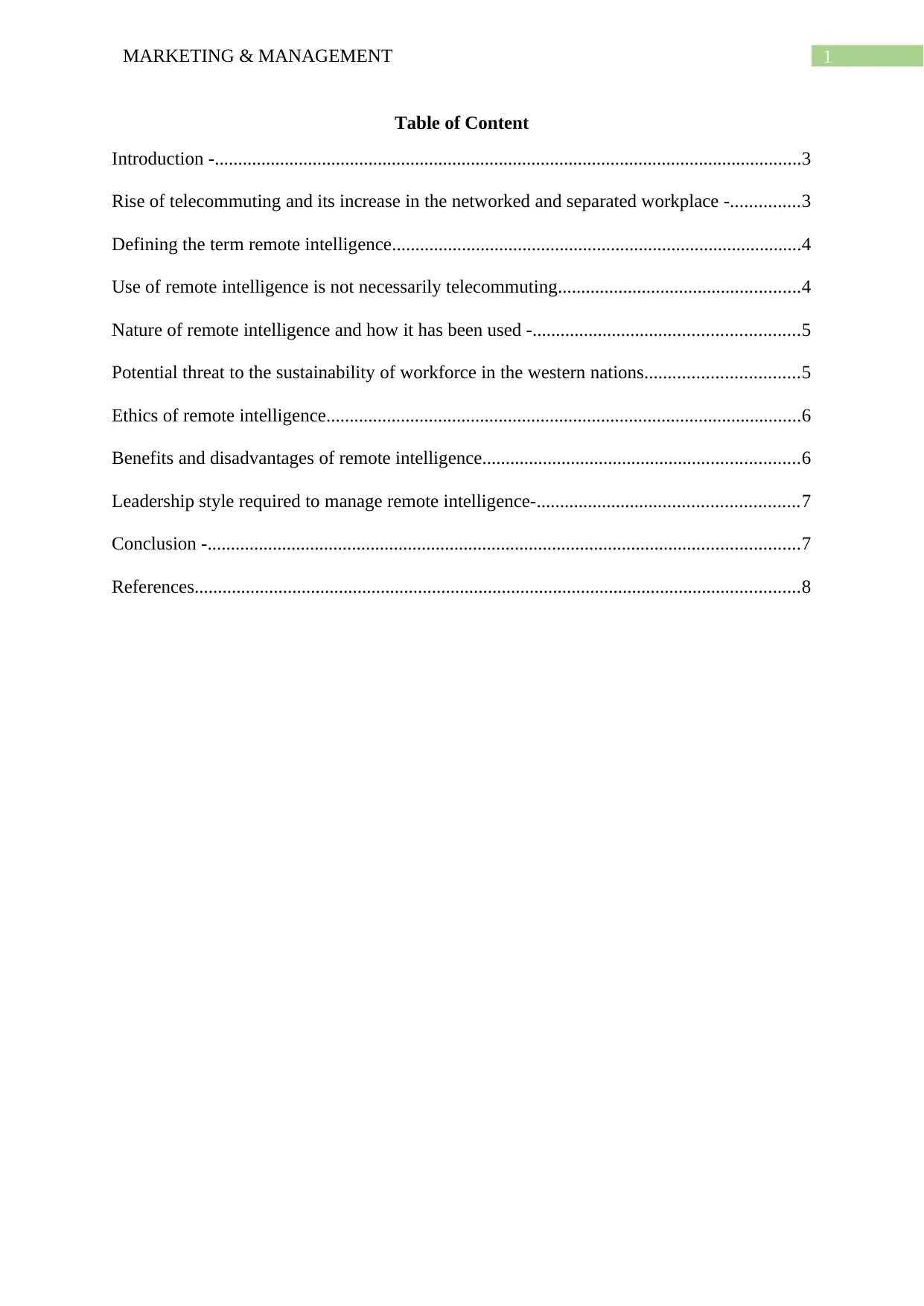
1MARKETING & MANAGEMENT
Table of Content
Introduction -..............................................................................................................................3
Rise of telecommuting and its increase in the networked and separated workplace -...............3
Defining the term remote intelligence........................................................................................4
Use of remote intelligence is not necessarily telecommuting....................................................4
Nature of remote intelligence and how it has been used -.........................................................5
Potential threat to the sustainability of workforce in the western nations.................................5
Ethics of remote intelligence......................................................................................................6
Benefits and disadvantages of remote intelligence....................................................................6
Leadership style required to manage remote intelligence-........................................................7
Conclusion -...............................................................................................................................7
References..................................................................................................................................8
Table of Content
Introduction -..............................................................................................................................3
Rise of telecommuting and its increase in the networked and separated workplace -...............3
Defining the term remote intelligence........................................................................................4
Use of remote intelligence is not necessarily telecommuting....................................................4
Nature of remote intelligence and how it has been used -.........................................................5
Potential threat to the sustainability of workforce in the western nations.................................5
Ethics of remote intelligence......................................................................................................6
Benefits and disadvantages of remote intelligence....................................................................6
Leadership style required to manage remote intelligence-........................................................7
Conclusion -...............................................................................................................................7
References..................................................................................................................................8
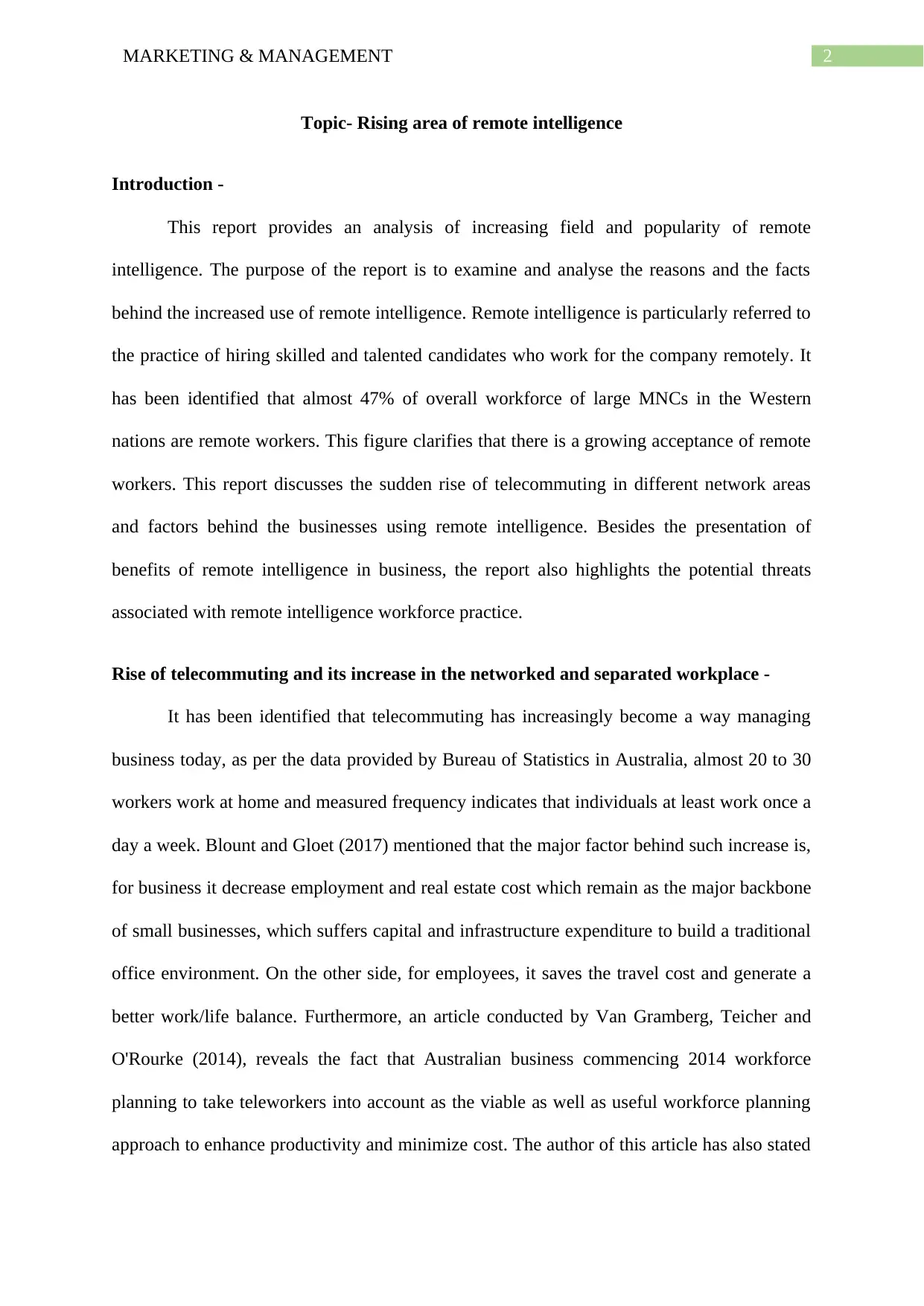
2MARKETING & MANAGEMENT
Topic- Rising area of remote intelligence
Introduction -
This report provides an analysis of increasing field and popularity of remote
intelligence. The purpose of the report is to examine and analyse the reasons and the facts
behind the increased use of remote intelligence. Remote intelligence is particularly referred to
the practice of hiring skilled and talented candidates who work for the company remotely. It
has been identified that almost 47% of overall workforce of large MNCs in the Western
nations are remote workers. This figure clarifies that there is a growing acceptance of remote
workers. This report discusses the sudden rise of telecommuting in different network areas
and factors behind the businesses using remote intelligence. Besides the presentation of
benefits of remote intelligence in business, the report also highlights the potential threats
associated with remote intelligence workforce practice.
Rise of telecommuting and its increase in the networked and separated workplace -
It has been identified that telecommuting has increasingly become a way managing
business today, as per the data provided by Bureau of Statistics in Australia, almost 20 to 30
workers work at home and measured frequency indicates that individuals at least work once a
day a week. Blount and Gloet (2017) mentioned that the major factor behind such increase is,
for business it decrease employment and real estate cost which remain as the major backbone
of small businesses, which suffers capital and infrastructure expenditure to build a traditional
office environment. On the other side, for employees, it saves the travel cost and generate a
better work/life balance. Furthermore, an article conducted by Van Gramberg, Teicher and
O'Rourke (2014), reveals the fact that Australian business commencing 2014 workforce
planning to take teleworkers into account as the viable as well as useful workforce planning
approach to enhance productivity and minimize cost. The author of this article has also stated
Topic- Rising area of remote intelligence
Introduction -
This report provides an analysis of increasing field and popularity of remote
intelligence. The purpose of the report is to examine and analyse the reasons and the facts
behind the increased use of remote intelligence. Remote intelligence is particularly referred to
the practice of hiring skilled and talented candidates who work for the company remotely. It
has been identified that almost 47% of overall workforce of large MNCs in the Western
nations are remote workers. This figure clarifies that there is a growing acceptance of remote
workers. This report discusses the sudden rise of telecommuting in different network areas
and factors behind the businesses using remote intelligence. Besides the presentation of
benefits of remote intelligence in business, the report also highlights the potential threats
associated with remote intelligence workforce practice.
Rise of telecommuting and its increase in the networked and separated workplace -
It has been identified that telecommuting has increasingly become a way managing
business today, as per the data provided by Bureau of Statistics in Australia, almost 20 to 30
workers work at home and measured frequency indicates that individuals at least work once a
day a week. Blount and Gloet (2017) mentioned that the major factor behind such increase is,
for business it decrease employment and real estate cost which remain as the major backbone
of small businesses, which suffers capital and infrastructure expenditure to build a traditional
office environment. On the other side, for employees, it saves the travel cost and generate a
better work/life balance. Furthermore, an article conducted by Van Gramberg, Teicher and
O'Rourke (2014), reveals the fact that Australian business commencing 2014 workforce
planning to take teleworkers into account as the viable as well as useful workforce planning
approach to enhance productivity and minimize cost. The author of this article has also stated
⊘ This is a preview!⊘
Do you want full access?
Subscribe today to unlock all pages.

Trusted by 1+ million students worldwide
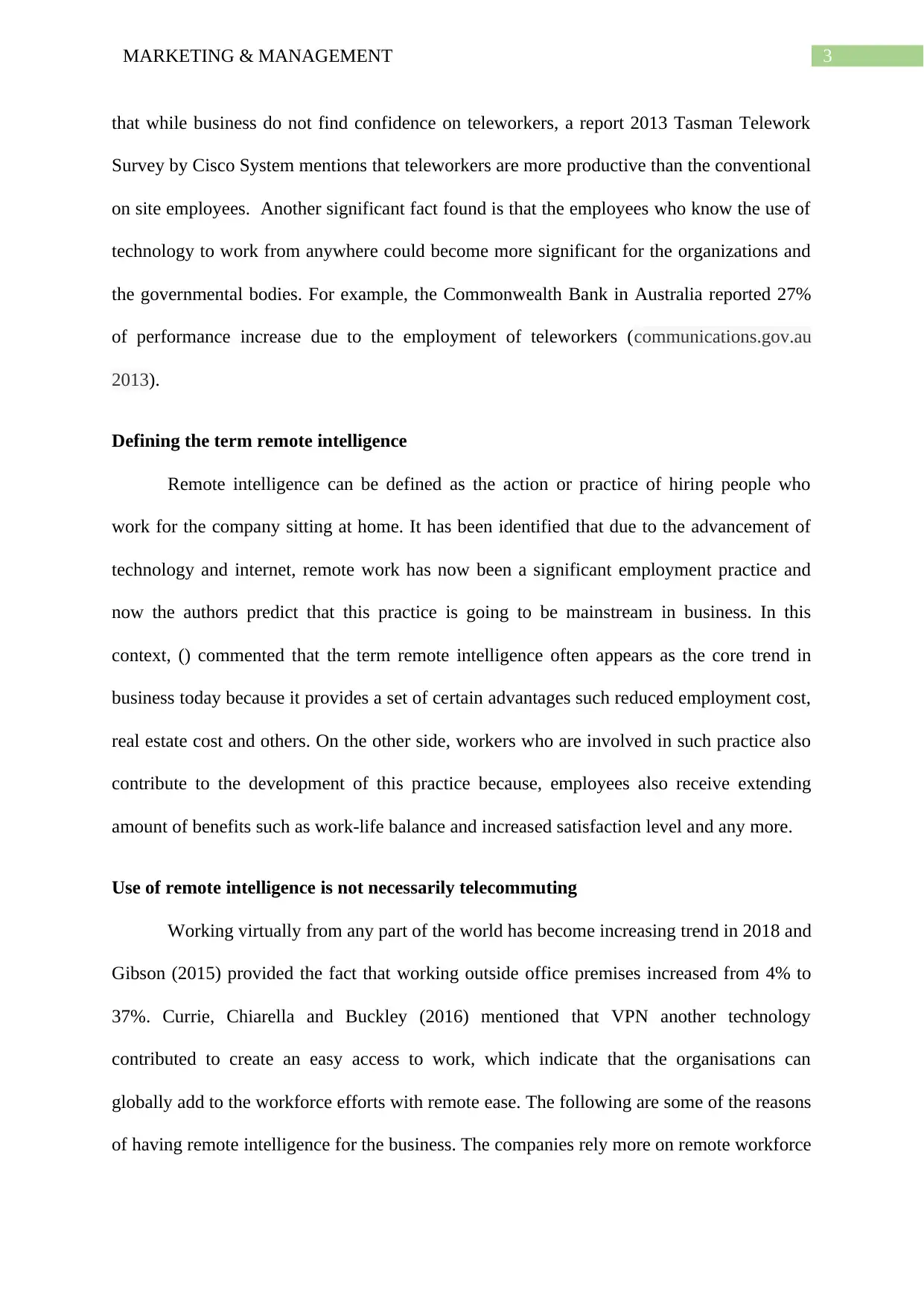
3MARKETING & MANAGEMENT
that while business do not find confidence on teleworkers, a report 2013 Tasman Telework
Survey by Cisco System mentions that teleworkers are more productive than the conventional
on site employees. Another significant fact found is that the employees who know the use of
technology to work from anywhere could become more significant for the organizations and
the governmental bodies. For example, the Commonwealth Bank in Australia reported 27%
of performance increase due to the employment of teleworkers (communications.gov.au
2013).
Defining the term remote intelligence
Remote intelligence can be defined as the action or practice of hiring people who
work for the company sitting at home. It has been identified that due to the advancement of
technology and internet, remote work has now been a significant employment practice and
now the authors predict that this practice is going to be mainstream in business. In this
context, () commented that the term remote intelligence often appears as the core trend in
business today because it provides a set of certain advantages such reduced employment cost,
real estate cost and others. On the other side, workers who are involved in such practice also
contribute to the development of this practice because, employees also receive extending
amount of benefits such as work-life balance and increased satisfaction level and any more.
Use of remote intelligence is not necessarily telecommuting
Working virtually from any part of the world has become increasing trend in 2018 and
Gibson (2015) provided the fact that working outside office premises increased from 4% to
37%. Currie, Chiarella and Buckley (2016) mentioned that VPN another technology
contributed to create an easy access to work, which indicate that the organisations can
globally add to the workforce efforts with remote ease. The following are some of the reasons
of having remote intelligence for the business. The companies rely more on remote workforce
that while business do not find confidence on teleworkers, a report 2013 Tasman Telework
Survey by Cisco System mentions that teleworkers are more productive than the conventional
on site employees. Another significant fact found is that the employees who know the use of
technology to work from anywhere could become more significant for the organizations and
the governmental bodies. For example, the Commonwealth Bank in Australia reported 27%
of performance increase due to the employment of teleworkers (communications.gov.au
2013).
Defining the term remote intelligence
Remote intelligence can be defined as the action or practice of hiring people who
work for the company sitting at home. It has been identified that due to the advancement of
technology and internet, remote work has now been a significant employment practice and
now the authors predict that this practice is going to be mainstream in business. In this
context, () commented that the term remote intelligence often appears as the core trend in
business today because it provides a set of certain advantages such reduced employment cost,
real estate cost and others. On the other side, workers who are involved in such practice also
contribute to the development of this practice because, employees also receive extending
amount of benefits such as work-life balance and increased satisfaction level and any more.
Use of remote intelligence is not necessarily telecommuting
Working virtually from any part of the world has become increasing trend in 2018 and
Gibson (2015) provided the fact that working outside office premises increased from 4% to
37%. Currie, Chiarella and Buckley (2016) mentioned that VPN another technology
contributed to create an easy access to work, which indicate that the organisations can
globally add to the workforce efforts with remote ease. The following are some of the reasons
of having remote intelligence for the business. The companies rely more on remote workforce
Paraphrase This Document
Need a fresh take? Get an instant paraphrase of this document with our AI Paraphraser
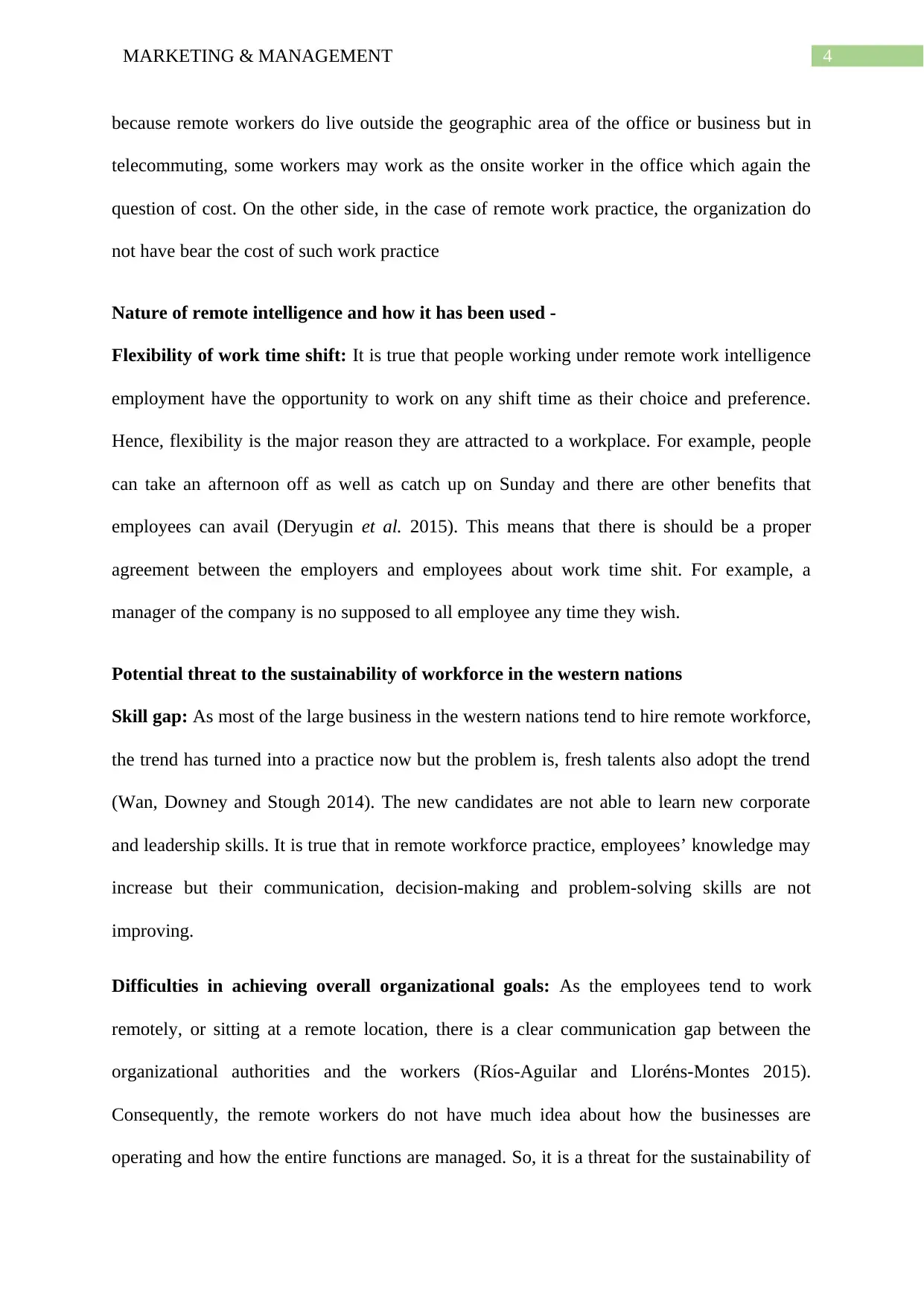
4MARKETING & MANAGEMENT
because remote workers do live outside the geographic area of the office or business but in
telecommuting, some workers may work as the onsite worker in the office which again the
question of cost. On the other side, in the case of remote work practice, the organization do
not have bear the cost of such work practice
Nature of remote intelligence and how it has been used -
Flexibility of work time shift: It is true that people working under remote work intelligence
employment have the opportunity to work on any shift time as their choice and preference.
Hence, flexibility is the major reason they are attracted to a workplace. For example, people
can take an afternoon off as well as catch up on Sunday and there are other benefits that
employees can avail (Deryugin et al. 2015). This means that there is should be a proper
agreement between the employers and employees about work time shit. For example, a
manager of the company is no supposed to all employee any time they wish.
Potential threat to the sustainability of workforce in the western nations
Skill gap: As most of the large business in the western nations tend to hire remote workforce,
the trend has turned into a practice now but the problem is, fresh talents also adopt the trend
(Wan, Downey and Stough 2014). The new candidates are not able to learn new corporate
and leadership skills. It is true that in remote workforce practice, employees’ knowledge may
increase but their communication, decision-making and problem-solving skills are not
improving.
Difficulties in achieving overall organizational goals: As the employees tend to work
remotely, or sitting at a remote location, there is a clear communication gap between the
organizational authorities and the workers (Ríos-Aguilar and Lloréns-Montes 2015).
Consequently, the remote workers do not have much idea about how the businesses are
operating and how the entire functions are managed. So, it is a threat for the sustainability of
because remote workers do live outside the geographic area of the office or business but in
telecommuting, some workers may work as the onsite worker in the office which again the
question of cost. On the other side, in the case of remote work practice, the organization do
not have bear the cost of such work practice
Nature of remote intelligence and how it has been used -
Flexibility of work time shift: It is true that people working under remote work intelligence
employment have the opportunity to work on any shift time as their choice and preference.
Hence, flexibility is the major reason they are attracted to a workplace. For example, people
can take an afternoon off as well as catch up on Sunday and there are other benefits that
employees can avail (Deryugin et al. 2015). This means that there is should be a proper
agreement between the employers and employees about work time shit. For example, a
manager of the company is no supposed to all employee any time they wish.
Potential threat to the sustainability of workforce in the western nations
Skill gap: As most of the large business in the western nations tend to hire remote workforce,
the trend has turned into a practice now but the problem is, fresh talents also adopt the trend
(Wan, Downey and Stough 2014). The new candidates are not able to learn new corporate
and leadership skills. It is true that in remote workforce practice, employees’ knowledge may
increase but their communication, decision-making and problem-solving skills are not
improving.
Difficulties in achieving overall organizational goals: As the employees tend to work
remotely, or sitting at a remote location, there is a clear communication gap between the
organizational authorities and the workers (Ríos-Aguilar and Lloréns-Montes 2015).
Consequently, the remote workers do not have much idea about how the businesses are
operating and how the entire functions are managed. So, it is a threat for the sustainability of
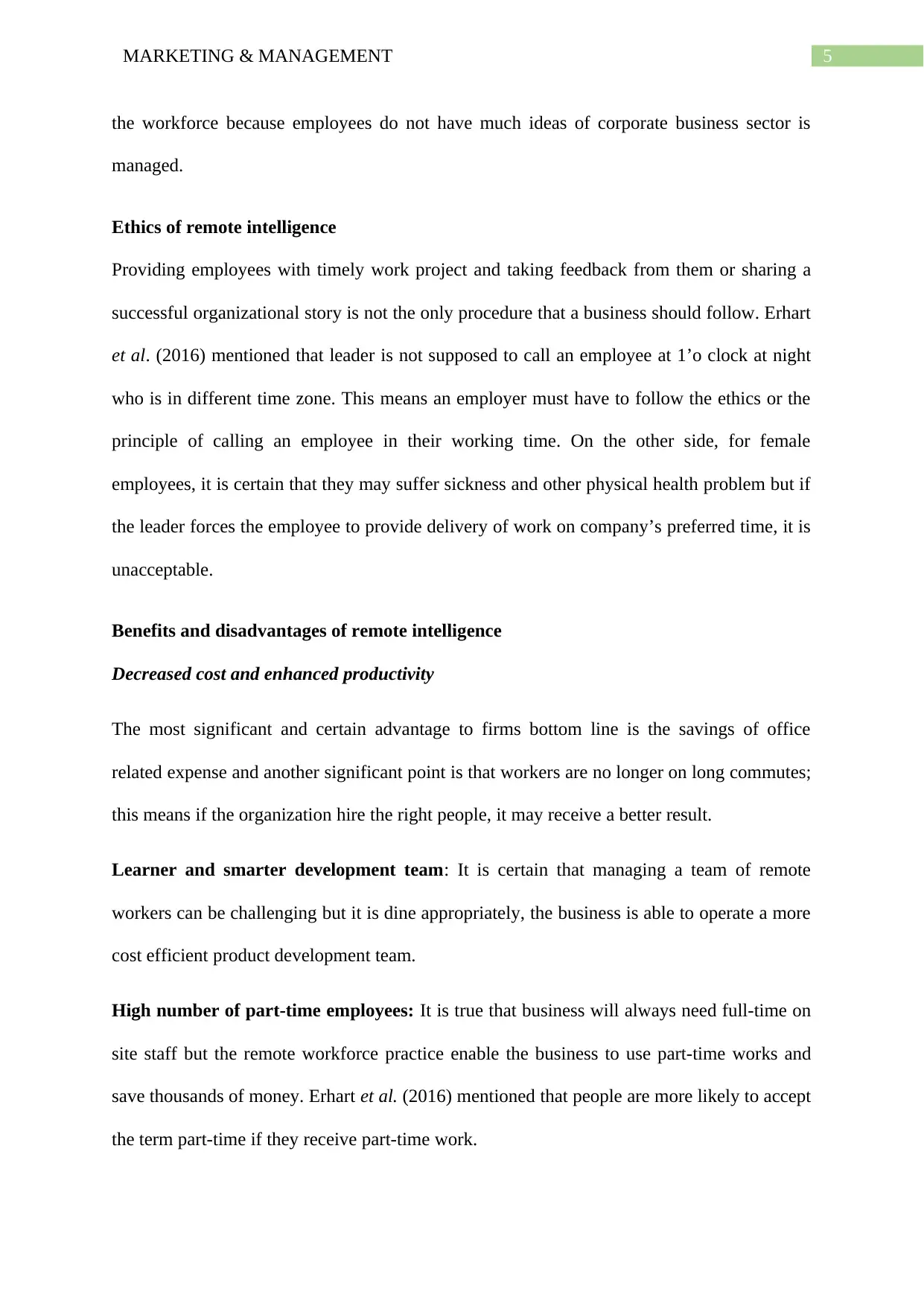
5MARKETING & MANAGEMENT
the workforce because employees do not have much ideas of corporate business sector is
managed.
Ethics of remote intelligence
Providing employees with timely work project and taking feedback from them or sharing a
successful organizational story is not the only procedure that a business should follow. Erhart
et al. (2016) mentioned that leader is not supposed to call an employee at 1’o clock at night
who is in different time zone. This means an employer must have to follow the ethics or the
principle of calling an employee in their working time. On the other side, for female
employees, it is certain that they may suffer sickness and other physical health problem but if
the leader forces the employee to provide delivery of work on company’s preferred time, it is
unacceptable.
Benefits and disadvantages of remote intelligence
Decreased cost and enhanced productivity
The most significant and certain advantage to firms bottom line is the savings of office
related expense and another significant point is that workers are no longer on long commutes;
this means if the organization hire the right people, it may receive a better result.
Learner and smarter development team: It is certain that managing a team of remote
workers can be challenging but it is dine appropriately, the business is able to operate a more
cost efficient product development team.
High number of part-time employees: It is true that business will always need full-time on
site staff but the remote workforce practice enable the business to use part-time works and
save thousands of money. Erhart et al. (2016) mentioned that people are more likely to accept
the term part-time if they receive part-time work.
the workforce because employees do not have much ideas of corporate business sector is
managed.
Ethics of remote intelligence
Providing employees with timely work project and taking feedback from them or sharing a
successful organizational story is not the only procedure that a business should follow. Erhart
et al. (2016) mentioned that leader is not supposed to call an employee at 1’o clock at night
who is in different time zone. This means an employer must have to follow the ethics or the
principle of calling an employee in their working time. On the other side, for female
employees, it is certain that they may suffer sickness and other physical health problem but if
the leader forces the employee to provide delivery of work on company’s preferred time, it is
unacceptable.
Benefits and disadvantages of remote intelligence
Decreased cost and enhanced productivity
The most significant and certain advantage to firms bottom line is the savings of office
related expense and another significant point is that workers are no longer on long commutes;
this means if the organization hire the right people, it may receive a better result.
Learner and smarter development team: It is certain that managing a team of remote
workers can be challenging but it is dine appropriately, the business is able to operate a more
cost efficient product development team.
High number of part-time employees: It is true that business will always need full-time on
site staff but the remote workforce practice enable the business to use part-time works and
save thousands of money. Erhart et al. (2016) mentioned that people are more likely to accept
the term part-time if they receive part-time work.
⊘ This is a preview!⊘
Do you want full access?
Subscribe today to unlock all pages.

Trusted by 1+ million students worldwide
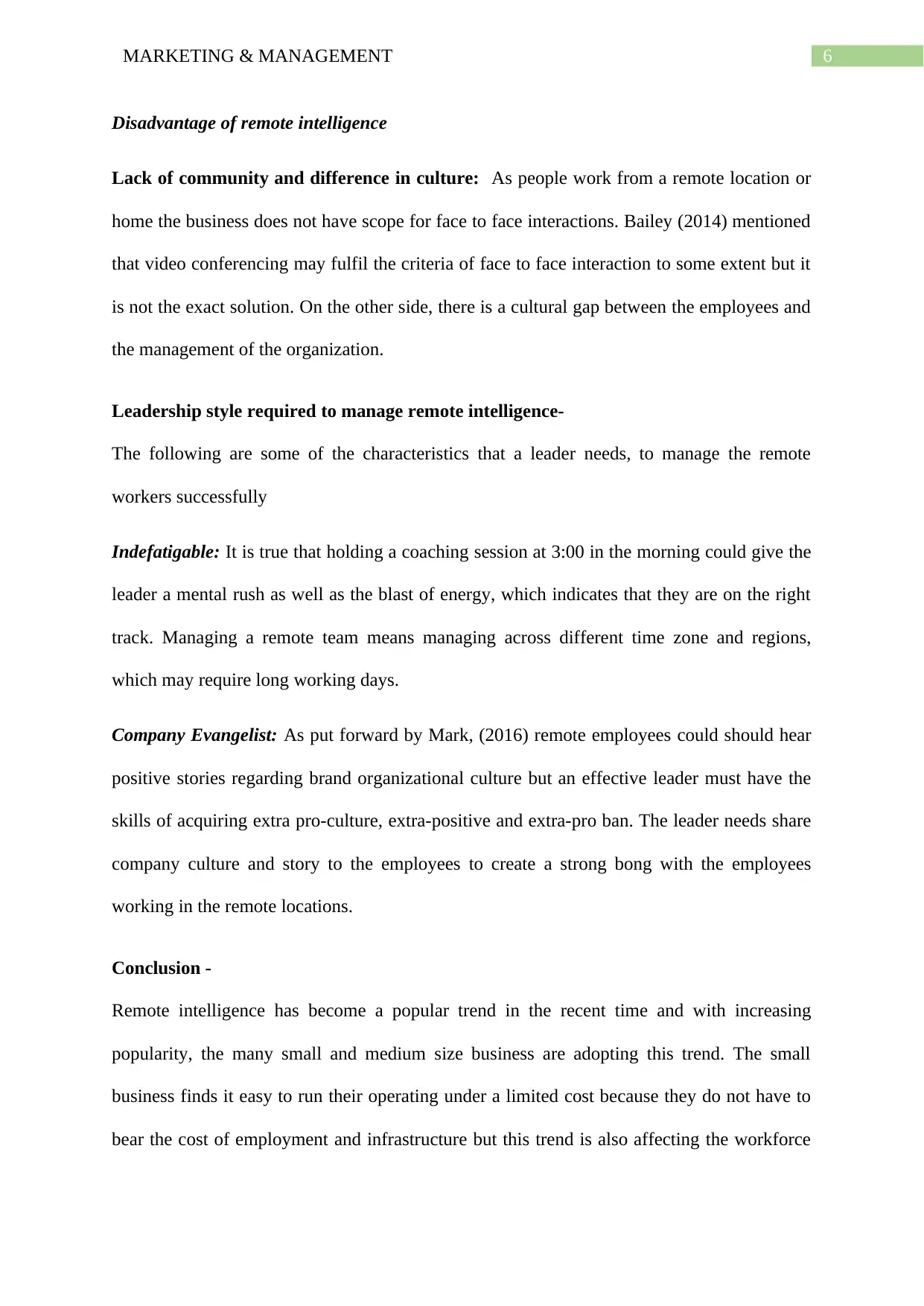
6MARKETING & MANAGEMENT
Disadvantage of remote intelligence
Lack of community and difference in culture: As people work from a remote location or
home the business does not have scope for face to face interactions. Bailey (2014) mentioned
that video conferencing may fulfil the criteria of face to face interaction to some extent but it
is not the exact solution. On the other side, there is a cultural gap between the employees and
the management of the organization.
Leadership style required to manage remote intelligence-
The following are some of the characteristics that a leader needs, to manage the remote
workers successfully
Indefatigable: It is true that holding a coaching session at 3:00 in the morning could give the
leader a mental rush as well as the blast of energy, which indicates that they are on the right
track. Managing a remote team means managing across different time zone and regions,
which may require long working days.
Company Evangelist: As put forward by Mark, (2016) remote employees could should hear
positive stories regarding brand organizational culture but an effective leader must have the
skills of acquiring extra pro-culture, extra-positive and extra-pro ban. The leader needs share
company culture and story to the employees to create a strong bong with the employees
working in the remote locations.
Conclusion -
Remote intelligence has become a popular trend in the recent time and with increasing
popularity, the many small and medium size business are adopting this trend. The small
business finds it easy to run their operating under a limited cost because they do not have to
bear the cost of employment and infrastructure but this trend is also affecting the workforce
Disadvantage of remote intelligence
Lack of community and difference in culture: As people work from a remote location or
home the business does not have scope for face to face interactions. Bailey (2014) mentioned
that video conferencing may fulfil the criteria of face to face interaction to some extent but it
is not the exact solution. On the other side, there is a cultural gap between the employees and
the management of the organization.
Leadership style required to manage remote intelligence-
The following are some of the characteristics that a leader needs, to manage the remote
workers successfully
Indefatigable: It is true that holding a coaching session at 3:00 in the morning could give the
leader a mental rush as well as the blast of energy, which indicates that they are on the right
track. Managing a remote team means managing across different time zone and regions,
which may require long working days.
Company Evangelist: As put forward by Mark, (2016) remote employees could should hear
positive stories regarding brand organizational culture but an effective leader must have the
skills of acquiring extra pro-culture, extra-positive and extra-pro ban. The leader needs share
company culture and story to the employees to create a strong bong with the employees
working in the remote locations.
Conclusion -
Remote intelligence has become a popular trend in the recent time and with increasing
popularity, the many small and medium size business are adopting this trend. The small
business finds it easy to run their operating under a limited cost because they do not have to
bear the cost of employment and infrastructure but this trend is also affecting the workforce
Paraphrase This Document
Need a fresh take? Get an instant paraphrase of this document with our AI Paraphraser
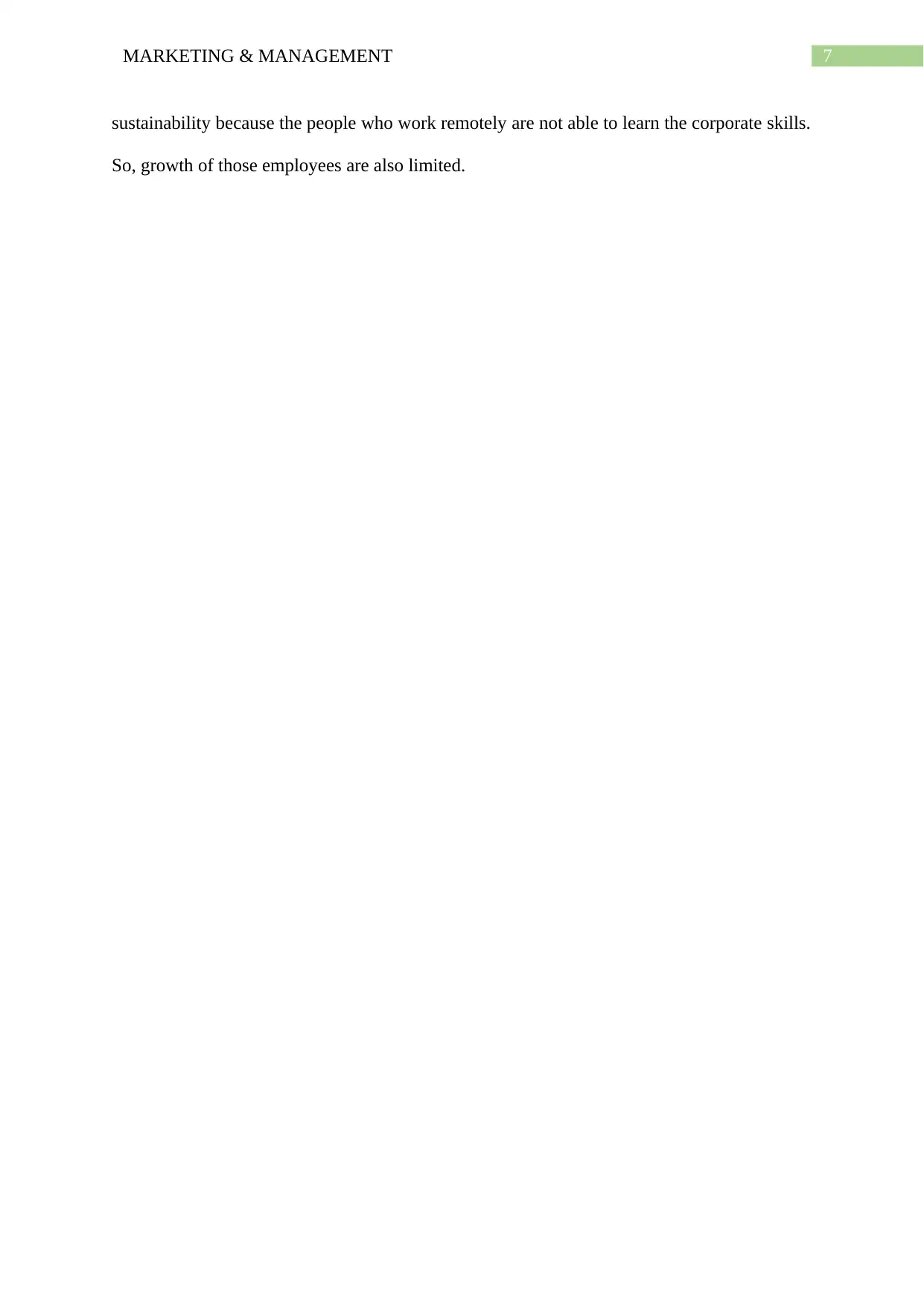
7MARKETING & MANAGEMENT
sustainability because the people who work remotely are not able to learn the corporate skills.
So, growth of those employees are also limited.
sustainability because the people who work remotely are not able to learn the corporate skills.
So, growth of those employees are also limited.
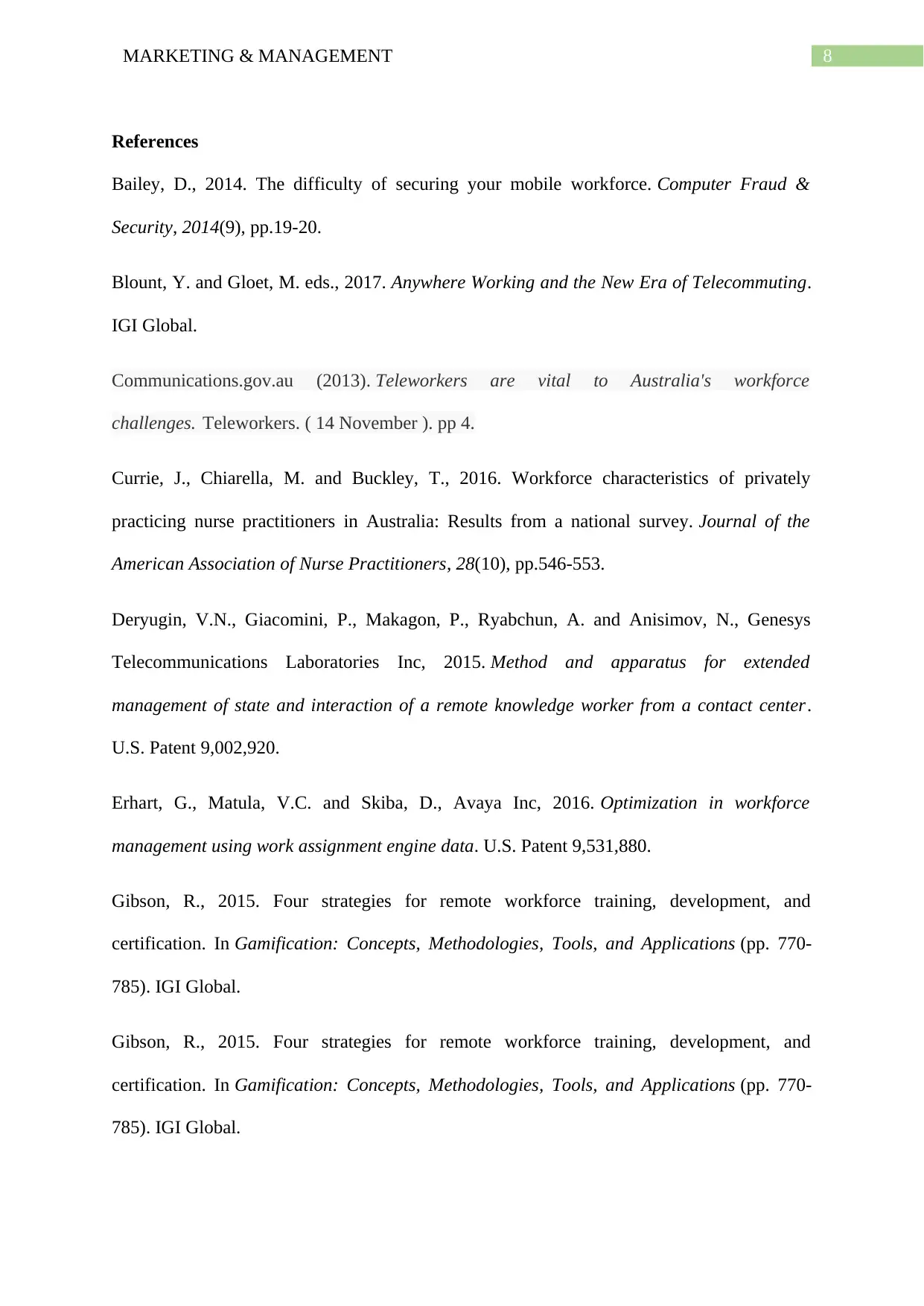
8MARKETING & MANAGEMENT
References
Bailey, D., 2014. The difficulty of securing your mobile workforce. Computer Fraud &
Security, 2014(9), pp.19-20.
Blount, Y. and Gloet, M. eds., 2017. Anywhere Working and the New Era of Telecommuting.
IGI Global.
Communications.gov.au (2013). Teleworkers are vital to Australia's workforce
challenges. Teleworkers. ( 14 November ). pp 4.
Currie, J., Chiarella, M. and Buckley, T., 2016. Workforce characteristics of privately
practicing nurse practitioners in Australia: Results from a national survey. Journal of the
American Association of Nurse Practitioners, 28(10), pp.546-553.
Deryugin, V.N., Giacomini, P., Makagon, P., Ryabchun, A. and Anisimov, N., Genesys
Telecommunications Laboratories Inc, 2015. Method and apparatus for extended
management of state and interaction of a remote knowledge worker from a contact center.
U.S. Patent 9,002,920.
Erhart, G., Matula, V.C. and Skiba, D., Avaya Inc, 2016. Optimization in workforce
management using work assignment engine data. U.S. Patent 9,531,880.
Gibson, R., 2015. Four strategies for remote workforce training, development, and
certification. In Gamification: Concepts, Methodologies, Tools, and Applications (pp. 770-
785). IGI Global.
Gibson, R., 2015. Four strategies for remote workforce training, development, and
certification. In Gamification: Concepts, Methodologies, Tools, and Applications (pp. 770-
785). IGI Global.
References
Bailey, D., 2014. The difficulty of securing your mobile workforce. Computer Fraud &
Security, 2014(9), pp.19-20.
Blount, Y. and Gloet, M. eds., 2017. Anywhere Working and the New Era of Telecommuting.
IGI Global.
Communications.gov.au (2013). Teleworkers are vital to Australia's workforce
challenges. Teleworkers. ( 14 November ). pp 4.
Currie, J., Chiarella, M. and Buckley, T., 2016. Workforce characteristics of privately
practicing nurse practitioners in Australia: Results from a national survey. Journal of the
American Association of Nurse Practitioners, 28(10), pp.546-553.
Deryugin, V.N., Giacomini, P., Makagon, P., Ryabchun, A. and Anisimov, N., Genesys
Telecommunications Laboratories Inc, 2015. Method and apparatus for extended
management of state and interaction of a remote knowledge worker from a contact center.
U.S. Patent 9,002,920.
Erhart, G., Matula, V.C. and Skiba, D., Avaya Inc, 2016. Optimization in workforce
management using work assignment engine data. U.S. Patent 9,531,880.
Gibson, R., 2015. Four strategies for remote workforce training, development, and
certification. In Gamification: Concepts, Methodologies, Tools, and Applications (pp. 770-
785). IGI Global.
Gibson, R., 2015. Four strategies for remote workforce training, development, and
certification. In Gamification: Concepts, Methodologies, Tools, and Applications (pp. 770-
785). IGI Global.
⊘ This is a preview!⊘
Do you want full access?
Subscribe today to unlock all pages.

Trusted by 1+ million students worldwide
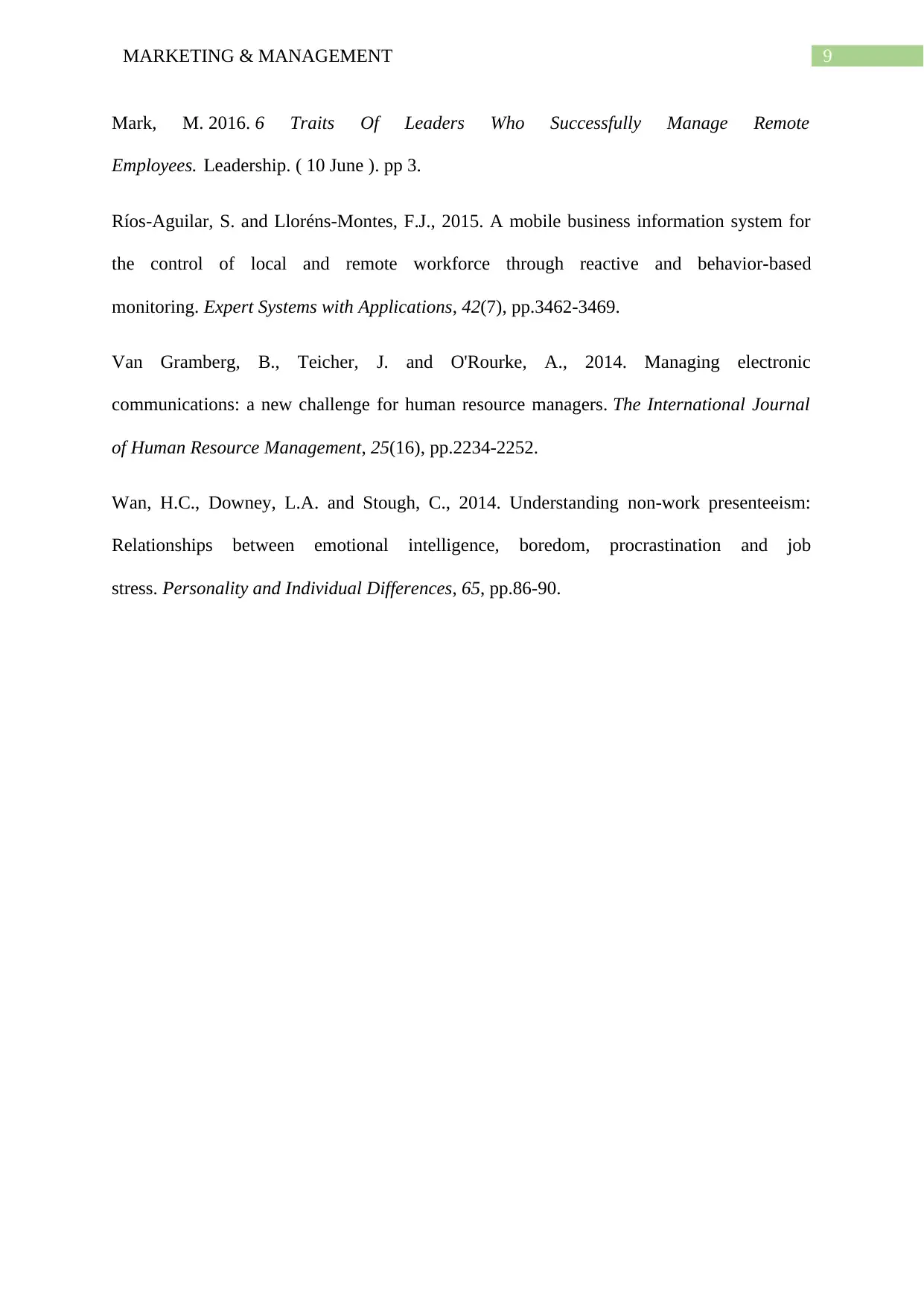
9MARKETING & MANAGEMENT
Mark, M. 2016. 6 Traits Of Leaders Who Successfully Manage Remote
Employees. Leadership. ( 10 June ). pp 3.
Ríos-Aguilar, S. and Lloréns-Montes, F.J., 2015. A mobile business information system for
the control of local and remote workforce through reactive and behavior-based
monitoring. Expert Systems with Applications, 42(7), pp.3462-3469.
Van Gramberg, B., Teicher, J. and O'Rourke, A., 2014. Managing electronic
communications: a new challenge for human resource managers. The International Journal
of Human Resource Management, 25(16), pp.2234-2252.
Wan, H.C., Downey, L.A. and Stough, C., 2014. Understanding non-work presenteeism:
Relationships between emotional intelligence, boredom, procrastination and job
stress. Personality and Individual Differences, 65, pp.86-90.
Mark, M. 2016. 6 Traits Of Leaders Who Successfully Manage Remote
Employees. Leadership. ( 10 June ). pp 3.
Ríos-Aguilar, S. and Lloréns-Montes, F.J., 2015. A mobile business information system for
the control of local and remote workforce through reactive and behavior-based
monitoring. Expert Systems with Applications, 42(7), pp.3462-3469.
Van Gramberg, B., Teicher, J. and O'Rourke, A., 2014. Managing electronic
communications: a new challenge for human resource managers. The International Journal
of Human Resource Management, 25(16), pp.2234-2252.
Wan, H.C., Downey, L.A. and Stough, C., 2014. Understanding non-work presenteeism:
Relationships between emotional intelligence, boredom, procrastination and job
stress. Personality and Individual Differences, 65, pp.86-90.
1 out of 10
Related Documents
Your All-in-One AI-Powered Toolkit for Academic Success.
+13062052269
info@desklib.com
Available 24*7 on WhatsApp / Email
![[object Object]](/_next/static/media/star-bottom.7253800d.svg)
Unlock your academic potential
Copyright © 2020–2025 A2Z Services. All Rights Reserved. Developed and managed by ZUCOL.





